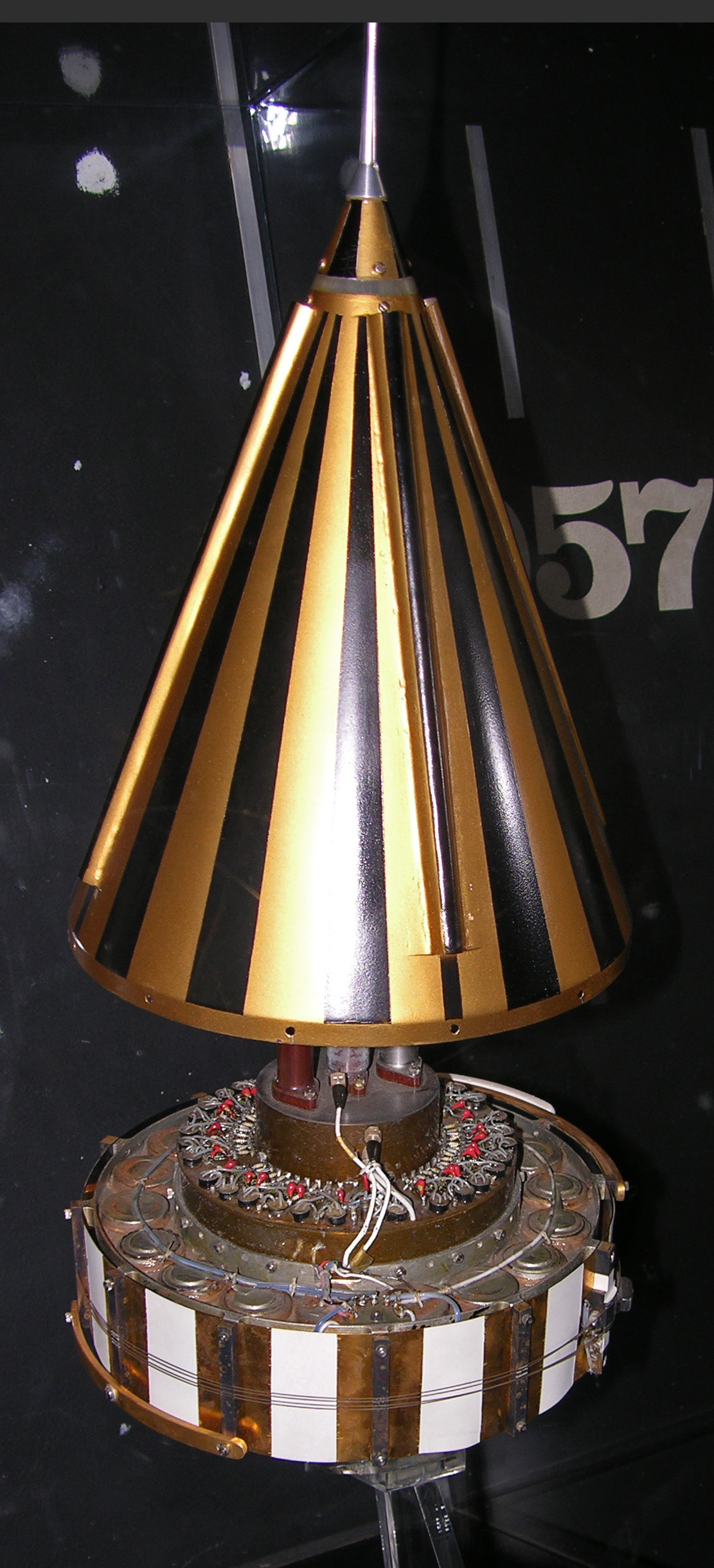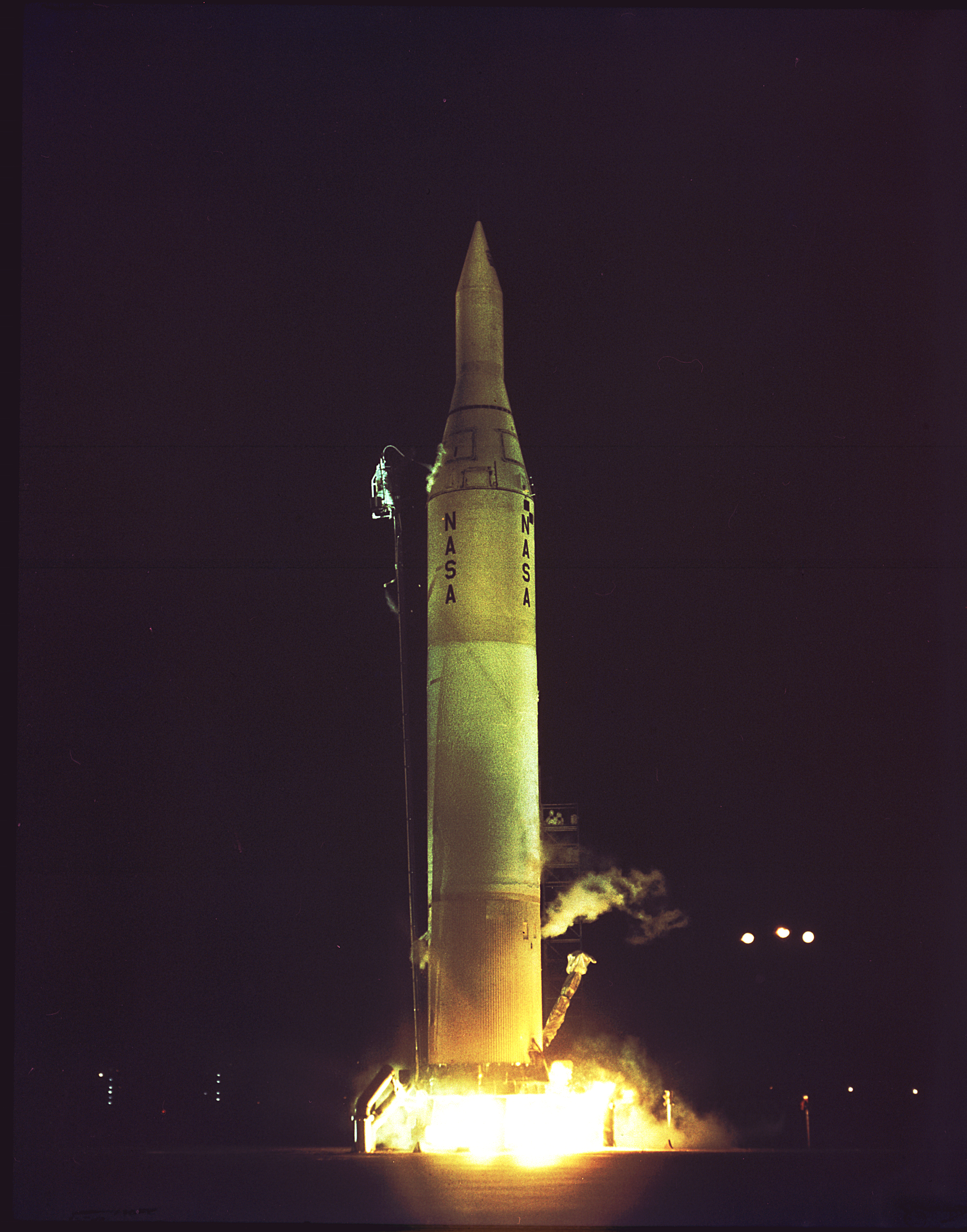Pioneer 4 on:
[Wikipedia]
[Google]
[Amazon]
Pioneer 4 was an American spin-stabilized
 ''Pioneer 4'' was a cone-shaped probe 51 cm high and 23 cm in diameter at its base. The cone was composed of a thin
''Pioneer 4'' was a cone-shaped probe 51 cm high and 23 cm in diameter at its base. The cone was composed of a thin
 ''Pioneer 4'' was launched with a
''Pioneer 4'' was launched with a
NASA JPL ''Pioneer 3'' and ''4''
NSSDC Master Catalog: Spacecraft ''Pioneer 4''
{{Orbital launches in 1959 Spacecraft launched in 1959 Derelict satellites in heliocentric orbit Missions to the Moon Pioneer 04 Lunar flybys March 1959 events in the United States
uncrewed spacecraft
Unmanned spacecraft or uncrewed spacecraft are spacecraft without people on board, used for robotic spaceflight. Uncrewed spacecraft may have varying levels of autonomy from human input; they may be remote controlled, remote guided or ev ...
launched as part of the Pioneer program
The Pioneer programs were two series of United States lunar and planetary space probes exploration. The first program, which ran from 1958 to 1960, unsuccessfully attempted to send spacecraft to orbit the Moon, successfully sent one spacecraft to ...
on a lunar flyby
A flyby () is a spaceflight operation in which a spacecraft passes in proximity to another body, usually a target of its space exploration mission and/or a source of a gravity assist to impel it towards another target. Spacecraft which are specif ...
trajectory and into a heliocentric orbit
A heliocentric orbit (also called circumsolar orbit) is an orbit around the barycenter of the Solar System, which is usually located within or very near the surface of the Sun. All planets, comets, and asteroids in the Solar System, and the Sun ...
making it the first probe of the United States
The United States of America (U.S.A. or USA), commonly known as the United States (U.S. or US) or America, is a country Continental United States, primarily located in North America. It consists of 50 U.S. state, states, a Washington, D.C., ...
to escape from the Earth's gravity. It carried a payload similar to '' Pioneer 3'': a lunar radiation environment experiment using a Geiger–Müller tube
The Geiger–Müller tube or G–M tube is the sensing element of the Geiger counter instrument used for the detection of ionizing radiation. It is named after Hans Geiger, who invented the principle in 1908, and Walther Müller, who collaborated ...
detector and a lunar photography experiment. It passed within 58,983 km of the Moon
The Moon is Earth's only natural satellite. It is the fifth largest satellite in the Solar System and the largest and most massive relative to its parent planet, with a diameter about one-quarter that of Earth (comparable to the width of ...
's surface. However, ''Pioneer 4'' did not come close enough to trigger its photoelectric sensor
A photoelectric sensor is a device used to determine the distance, absence, or presence of an object by using a light transmitter, often infrared, and a photoelectric receiver. They are largely used in industrial manufacturing. There are three ...
. The spacecraft was still in solar orbit as of 1969. It was the only successful lunar probe
The physical exploration of the Moon began when ''Luna 2'', a space probe launched by the Soviet Union, made an impact on the surface of the Moon on September 14, 1959. Prior to that the only available means of exploration had been observat ...
launched by the U.S. in 12 attempts between 1958 and 1963; only in 1964 would Ranger 7 surpass its success by accomplishing all of its mission objectives.
After the Soviet Luna 1 probe conducted the first successful flyby of the Moon on 3 January 1959, the pressure felt by the US to succeed with a lunar mission was enormous, especially since American mission failures were entirely public while the Soviet failures were kept a secret.
Spacecraft design
 ''Pioneer 4'' was a cone-shaped probe 51 cm high and 23 cm in diameter at its base. The cone was composed of a thin
''Pioneer 4'' was a cone-shaped probe 51 cm high and 23 cm in diameter at its base. The cone was composed of a thin fiberglass
Fiberglass ( American English) or fibreglass (Commonwealth English) is a common type of fiber-reinforced plastic using glass fiber. The fibers may be randomly arranged, flattened into a sheet called a chopped strand mat, or woven into glass cl ...
shell coated with a gold wash to make it electrically conducting and painted with white stripes to maintain the temperature between 10 and 50 °C. At the tip of the cone was a small probe which combined with the cone itself to act as an antenna. At the base of the cone, a ring of mercury batteries provided power. A photoelectric sensor
A photoelectric sensor is a device used to determine the distance, absence, or presence of an object by using a light transmitter, often infrared, and a photoelectric receiver. They are largely used in industrial manufacturing. There are three ...
protruded from the center of the ring. The sensor was designed with two photocells which would be triggered by the light of the Moon when the probe was within about 30,000 km of the Moon. At the center of the cone was a voltage supply tube and two Geiger–Müller tube
The Geiger–Müller tube or G–M tube is the sensing element of the Geiger counter instrument used for the detection of ionizing radiation. It is named after Hans Geiger, who invented the principle in 1908, and Walther Müller, who collaborated ...
s. The Laboratory's Microlock system, used for communicating with earlier Explorer satellites, did not have sufficient range to perform this mission. Therefore, a new radio system called TRAC(E) ''Tracking And Communication (Extraterrestrial)'' was designed. TRAC(E) was an integral part of the Goldstone Deep Space Communications Complex
The Goldstone Deep Space Communications Complex (GDSCC), commonly called the Goldstone Observatory, is a satellite ground station located in Fort Irwin in the U.S. state of California. Operated by NASA's Jet Propulsion Laboratory (JPL), its m ...
. A transmitter with a mass of 0.5 kg delivered a phase modulated
Phase modulation (PM) is a modulation pattern for conditioning communication signals for transmission. It encodes a message signal as variations in the instantaneous phase of a carrier wave. Phase modulation is one of the two principal forms ...
signal of 0.1 W at a frequency of 960.05 MHz. The modulated carrier power was 0.08 W and the total effective radiated power 0.18 W. A despin mechanism consisted of two 7 gram weights which spooled out to the end of two 150 cm wires when triggered by a hydraulic timer 10 hours after launch. The weights were designed to slow the spacecraft spin from 400 rpm to 6 rpm, and then weights and wires were released. Pioneer 4 received a few small modifications over its predecessor, namely added lead shielding around the Geiger tubes and modifications to the telemetry system to improve its reliability and signal strength. The probe had S/N #4, with probe #3 recalled from launch due to technical issues.
Launching vehicle
 ''Pioneer 4'' was launched with a
''Pioneer 4'' was launched with a Juno II
Juno II was an American space launch vehicle used during the late 1950s and early 1960s. It was derived from the Jupiter missile, which was used as the first stage.
Development
Solid rocket motors derived from the MGM-29 Sergeant were use ...
launch vehicle, which also launched ''Pioneer 3''. Juno II closely resembled the Juno I
The Juno I was a four-stage American space launch vehicle, used to launch lightweight payloads into low Earth orbit. The launch vehicle was used between January 1958 to December 1959. The launch vehicle was a member of the Redstone launch ve ...
(Jupiter-C
The Jupiter-C was an American research and development vehicle developed from the Jupiter-A. Jupiter-C was used for three unmanned sub-orbital spaceflights in 1956 and 1957 to test re-entry nosecones that were later to be deployed on the more ...
based) vehicle that launched Explorer 1
Explorer 1 was the first satellite launched by the United States in 1958 and was part of the U.S. participation in the International Geophysical Year (IGY). The mission followed the first two satellites the previous year; the Soviet Union's S ...
. Its first stage was a 19.51 m elongated Jupiter
Jupiter is the fifth planet from the Sun and the largest in the Solar System. It is a gas giant with a mass more than two and a half times that of all the other planets in the Solar System combined, but slightly less than one-thousand ...
IRBM
An intermediate-range ballistic missile (IRBM) is a ballistic missile with a range of 3,000–5,500 km (1,864–3,418 miles), between a medium-range ballistic missile (MRBM) and an intercontinental ballistic missile (ICBM). Classifying b ...
missile that was used by the U.S. Army
The United States Army (USA) is the land service branch of the United States Armed Forces. It is one of the eight U.S. uniformed services, and is designated as the Army of the United States in the U.S. Constitution.Article II, section 2, cl ...
. On top of the Jupiter propulsion section was a guidance and control compartment that supported a rotating tub containing the rocket stages 2, 3 and 4. ''Pioneer 4'' was mounted on top of stage 4.
Mission
At 05:10:56 GMT on the night of 3 March 1959, Pioneer 4 lifted off from LC-5 atCape Canaveral
, image = cape canaveral.jpg
, image_size = 300
, caption = View of Cape Canaveral from space in 1991
, map = Florida#USA
, map_width = 300
, type = Cape
, map_caption = Location in Florida
, location ...
. This time, the booster performed almost perfectly so that ''Pioneer 4'' achieved its primary objective (an Earth-Moon trajectory), returned radiation data and provided a valuable tracking exercise. A slightly longer than nominal second stage burn, however, was enough to induce small trajectory and velocity errors, so that the probe passed within 58,983 km of the Moon
The Moon is Earth's only natural satellite. It is the fifth largest satellite in the Solar System and the largest and most massive relative to its parent planet, with a diameter about one-quarter that of Earth (comparable to the width of ...
's surface (7.2° E, 5.7° S) on 4 March 1959 at 22:25 GMT (5:25 p.m. EST) at a speed of 7230 km/h. The distance was not close enough to trigger the photoelectric sensor. The probe continued transmitting radiation data for 82.5 hours, to a distance of , and reached perihelion on 18 March 1959 at 01:00 GMT. The cylindrical fourth stage casing (173 cm long, 15 cm diameter, 4.65 kg) went into orbit with the probe. The communication system had worked well, and it was estimated that signals could have been received out to had there been enough battery power.
See also
* Luna 1 – a similarSoviet space program
The Soviet space program (russian: Космическая программа СССР, Kosmicheskaya programma SSSR) was the national space program of the former Union of Soviet Socialist Republics (USSR), active from 1955 until the dissoluti ...
mission launched 2 January 1959, several weeks before ''Pioneer 4''.
References
External links
NASA JPL ''Pioneer 3'' and ''4''
NSSDC Master Catalog: Spacecraft ''Pioneer 4''
{{Orbital launches in 1959 Spacecraft launched in 1959 Derelict satellites in heliocentric orbit Missions to the Moon Pioneer 04 Lunar flybys March 1959 events in the United States